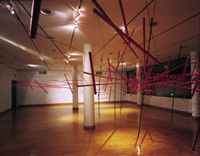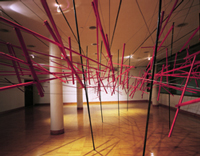

 |
 |
 |
 |
 |
 |
 |
 |
 |
 |
 |
 |
|
|
|
 |
 |
||||||||||||||||||||||||||
|
|
||||||||||||||||||||||||||

|
This installation employs the metaphor of the storm; a metaphor that begins, as all allusions do, in the very substance of the conditions they describe. Woods uses this metaphor to construct an installation that speculates on the effects that the destructive forces of history, such as war or natural catastrophe, can have on buildings and the architecture of cities, and the possibilities that this destructiveness offers for a radical design practice. In the chaos the storm sweeps before it, a "new order is set in motion," Woods states, and it is this reordering that allows for the emergence of new, previously unconsidered, architectural practices. The inability to predict the storm's events does not mitigate the necessity of attempting to understand or learn from its causes. As Woods writes, it is essential that "we architects must not abandon the knowledge of [architecture’s] constructed causes to the lack of knowledge in the uncertainty of its effects." | ||
|
With its speculation on the storms impact, this installation describes how rapid and often difficult forms of social change can be formulated architecturally and transformative processes can be balanced between the destructive and creative. For Woods, "Perhaps the storm can be understood as a convulsion of history, a ‘learning experience.’" The Storm was exhibited along with a collection of forty drawings from the War and Architecture Series (1992-5), which illustrate a series projects designed for the reconstruction of Sarajevo. These drawings and their accompanying texts propose new principles for the architectural reconstruction of cities that have been destroyed by war. | ||
|
Lebbeus Woods is an internationally renowned architect and theorist, a Professor in The Irwin S. Chanin School of Architecture at The Cooper Union, and a co-Founder and the Scientific Director of RIEAeuropa, an institute devoted to the advancement of experimental architectural thought and practice. His drawings and ideas on architecture have been collected in Radical Reconstruction (Princeton Architectural Press, 1997). His work is represented by the Henry Urbach Architecture Gallery (New York) and is in numerous private and public collections, including the Cooper-Hewitt National Design Museum, the San Francisco Museum of Modern Art, the Austrian Museum of Applied Art, the Carnegie Museum of Art, and the Getty Research Institute for the Arts and Humanities. CONSTRUCTED IN COLLABORATION WITH ALEXANDER GIL AND AMIR SHAHROKHI | ||